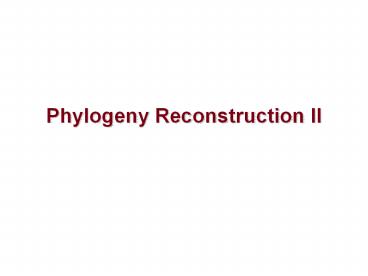Phylogeny Reconstruction II PowerPoint PPT Presentation
Title: Phylogeny Reconstruction II
1
Phylogeny Reconstruction II
2
Trees are like mobiles
The edges of tree can be freely rotated without
changing the relationships among the terminal
nodes.
3
Bifurcating and Multifurcating Trees
When all the internal nodes in a cladogram are
connected to three different nodes, the cladogram
is said a bifurcating tree. When one or more
internal nodes in a cladogram are connected to
more than three different nodes, the cladogram is
a multifurcating tree. The internal node is
referred as polytomy.
polytomies
Multifurcating trees
Bifurcating trees
4
Polytomy
polytomies
- Polytomy explains unresolved relationship of
taxa. - Polytomies can represent two different
situations
?
5
Polytomy
polytomies
- Polytomy explains unresolved relationship of
taxa. - Polytomies can represent two different
situations i) simultaneous divergence all the
descendants evolved at the same time (a hard
polytomy) ii) uncertainty of phylogenetic
relationships or lack of resolution due to
insufficient data (a soft polytomy)
6
Polytomy
hard polytomy (simultaneous divergence)
soft polytomy (uncertainty)
or
or
7
Rooted and Unrooted Trees
- Unrooted tree explains phylogenetic
relationshiops of taxa. Rooted tree explains
phylogenetic relationships of taxa and also the
direction of evolution of the taxa. - Root is
located at the base of a phylogenetic tree. It
represents the immediate ancestor to all the
terminal taxa of the tree.
root
root
Unrooted tree
Rooted tree
8
Tree Rooting
unrooted tree
rooted tree 1
rooted tree 2
rooted tree 3
rooted tree 4
rooted tree 5
rooted tree 6
rooted tree 7
9
Number of taxa
Number of unrooted tree
Number of rooted tree
1 1 3 15 105 945 10,395 135,135 2,027,025
1 3 15 105 945 10,395 135,135 2,027,025 34,459,425
2 3 4 5 6 7 8 9 10
10
Shorthand for Trees
Trees can be represented by a shorthand notation
that uses nested parentheses. Each internal node
is represented by a pair of parentheses that
enclose all descendants of that node. This format
makes it easy to describe a tree in the body of
some text without having to draw it. The format
is also used by many computer programmes to store
trees in data files.
A B C D E
(((A,B),C),(D,E))
11
Give a shorthand tree for the cladogram below.
A B C D E F G
H I J
A CLADOGRAM
12
Give a shorthand tree for the cladogram below.
A B C D E F G
H I J
A CLADOGRAM
(((A,B),C),((D,E),((F,G),(H,I,J))))
13
Sister taxa/group
Sister group(s) i) In cladistics two taxa or
clades which meet at a node or in other words
two lineages which diverged from that particular
common ancestor. Because sister groups share a
common ancestor, they are each other's closest
relatives. ii) Evolutionary theory The two
clades resulting from the splitting of a single
lineage. iii) a species or higher monophyletic
taxon that is hypothesized to be the closest
genealogical relative of a given taxon exclusive
of the ancestral species of both taxa.
14
Sister taxa/group
A B C D E F G
H I J
Sister taxa/group of (F,G)? Sister taxa/group of
B? Sister taxa/group of C? Sister taxa/group of
(D,E,F,G)?

